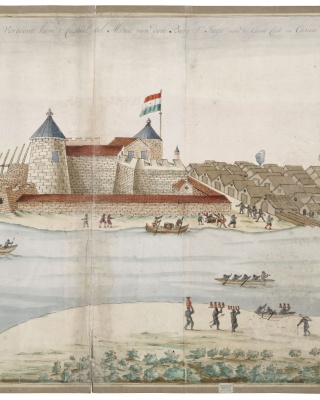Sources about slavery
Important archives on slavery have been digitised over the past years by the National Archives of the Netherlands, in cooperation with Metamorfoze, the Netherlands' national programme for the preservation of paper heritage. On this page, visitors can access the 1.9 million scans that have become available so far from institutions in the Netherlands, England, Guyana and Suriname. The scans from the collection of the National Archives of the Netherlands can be accessed and searched on this page. Links to scans from the collections of other (archival) institutions are also included.
As most of the digitised archives are written in Dutch, most inventories and scanned material are also only available in Dutch. There are some exceptions, however, visitors of this page should be aware that most linked content is not available in English or other languages. While it may be possible to translate some of this content using Google Translate (see box), most scans will still only be available in Dutch. This also means that in most cases, using non-Dutch search terms to search the archives will not yield the desired results.
Using Google Translate
The webpage can be accessed in languages other than Dutch by using the Google Translate extension. Instructions on how to install and use Google Translate on different devices can be found via the page about Google Translate in the Google Chrome webstore.
Please be aware that the archives and their inventories contain offensive and outdated terminology. Where possible, this terminology has been changed in inventories. However, no changes have been made to the scans of authentic material.
Digitised archives on this website
Slavery collections from other institutions
1.9 million archive items on slavery and the slave trade now accessible online
The outgoing Minister of Education, Culture and Science Ingrid van Engelshoven launches this webpage today. Visitors of this page will find an overview of archival records about the Dutch involvement in the history of slavery . A proximately 1.9 million archival items have been digitized. The newly digitized material includes scans from the West-Indische Compagnie, the Middelburgse Commercie Compagnie and the Sociëteit van Suriname, as well as documents including ships’ logbooks, plantation lists and letters. Much of the material has never been studied before.
Sources on slavery and the slave trade
The launch takes place during the symposium entitled ‘Bronnen over slavernij en slavenhandel’ (Sources on slavery and the slave trade), which is organized by the Rijksmuseum, the National Archives of the Netherlands and the KB, the national library of the Netherlands. The theme web page is the final result of a large-scale project of the Metamorfoze program in association with the National Archives of the Netherlands and the KB. These parties have been working alongside nine heritage organizations from the Netherlands, England, Guyana, and Suriname since 2013 to digitize a staggering 1.9 million archive items on the subject of slavery and the slave trade. After eight years of preservation work and digitization, the theme web page will now enable anyone who is interested to study the archives.
Research opportunities
The launch of this theme web page will provide online access to a wealth of important sources of information for research into the Dutch involvement in slavery and the history of the plantations. Historian and writer Leo Balai is delighted with the new research opportunities this access provides: “Metamorfoze is crucial to research, as it provides a relatively easy route to relevant sources. It allows you to find, read, discover and recount so much information.”
World heritage
The collection comprises of material from the archives of the West-Indische Compagnie, the Middelburgse Commercie Compagnie slave trade company, the Sociëteit van Berbice, the Sociëteit van Suriname, and the archive of the board of the Nederlandse Bezittingen ter Kuste van Guinea. Even the archive left in Guyana was brought to the Netherlands to be preserved and digitized. UNESCO has listed the archives of the West-Indische Compagnie and the Middelburgse Commercie Compagnie as world heritage, and they are currently being stored in the National Archive and the Zeeuws Archive respectively.
Special sources
The digitized archival material consists of special sources, including ships’ logbooks, shipment overviews, invoices, plantation lists, and letters from every tier of society. It also includes archives that had previously been assumed to be lost, such as part of the archive of Fort Elmina on the Dutch Gold Coast, which came to light during this programme. This archive is part of the famous Prize Papers, which were captured by the English and ended up in London. Much of the archive material is largely unused, but it gives an accurate impression of the slave trade and day-to-day life in the various colonies.

